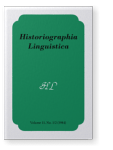El ‘Prosodion’ De Juan Gil De Zamora
Tradición Y Novedad
The paper is a preliminary synthesis of the work-in-progress on a critical edition of the Prosodion, a grammatical treatise by Gil de Zamora (fl. 1280). It begins with a biographical sketch of the author in which his work is placed within the grammatical trends of the Middle Ages. The next section deals with problems connected with the textual transmission, the distribution, and diffusion of the work. Two branches of filiation of the manuscripts, corresponding to two grammatical schools are distinguished: an Italian (viz. the Florence and Todi MSS) and a French school (viz. the Paris and Merville MSS). Given the change in the dedication and the considerable increase of the text, which shows a doubling of the original size in the most recent MSS (Todi), it is argued that a two-fold redaction must have taken place. Special importance is attached to the analysis of the sources of and their treatment in the Prosodion. It becomes obvious that Gil de Zamora is a mere compilator of grammatical works from different sources, which he arranges, adapts, and combines without any attempt at an original contribution.
The next section of the paper is devoted to an analysis of the organization and contents of the work. It reveals the Prosodion as a modernized version of Priscian’s Institutiones, largely guided by the scholastic, rational method of Petrus Helias. The three treatises which compose the work are analysed in the following order: (a) Orthography, with a list of terms of orthographical difficulties; (b) Prosody, with a glossary of terms and problems in matters of accentuation, and (c) a Treatise concerning punctuation and pauses. The concluding portion emphasizes essential features of Zamora’s work: Its harmonizing attitude towards ‘old’ and ‘modern’ grammarians, the survival of Priscian’s doctrines in 13th-century Spain, and the practical conception of grammar as opposed to the speculative trends in Paris and Northern Europe.
Article language: Spanish
References
Bibliografía citada
de Angelis, V.
ed. 1977 Papiae Elementarium. (
= Testi e Documenti per lo studio dell’ Antichità, LVIII. 1–3). Milano: Cisalpino Goliardica.

Castro y Castro, Manuel
ed. 1955 Iohannis Aegidii Zemorensis “De Preconiis Hispaniae” Madrid: Universidad.

Cremascoli, Giuseppe
1969 Il De “Dubio Accentu” di Uguccione da Pisa. Bologna: Magistri Artium.

Cremascoli, Giuseppe
ed. 1978 Uguccione da Pisa, “De Dubio Accentu. Agiographia”. Expositio de symbolo apostolorum. Pisa.

Chénu, Marie-Dominique
1969 La Théologie comme science au XIIIe siècle. Paris: Vrin.

Daly, Lloyd W.
ed. 1968 Brito Metricus: A Medieval verse Treatise on Greek and Hebrew Words. Philadelphia: Univ. of Pennsylvania Press.

Daly, Lloyd W.
ed. 1975 Summa Britonis. Padova: Antenore.

Douais, C.
1890 “
Les manuscrits du Château de Merville”.
Annales du Midi 21.333–336.

Faulhaber, Charles
ed. 1978 Juan Gil de Zamora. Dictaminis Epithalamium. Pisa: Pacini editore.

Faulhaber, Charles
ed. 1972 Latin Rhetorical Theory in 13nth and 14nth century Spain. Berkeley: University of California Press.

Gibson, Margaret
1979 “
The Early Scholastic ‘glossule’ to Priscian, Institutiones Grammaticae: The text and its influence”.
Studi Medievali 201:235–253.

Helias, Petrus
Summa supra Priscianum. París: Biblioteca del Arsenal, ms. 711.
Hunt, Richard William
1950 “
Hugutio and Petrus Helias”.
Mediaeval and Renaissance Studies 2:2.174–178 (Ahora también en
R. W. Hunt,
Collected Papers on the History of Grammar in the Middle Ages ed. by
G. L. Bursill-Hall (
= Studies in the History of Linguistics 5), 145–149. Amsterdam: J. Benjamins 1980.)

Lauer, Philippe
ed. 1939 Catalogue général des manuscrits latins. Paris: Bibliothèque Nationale.

Leonii, L.
1878 Inventario dei codici della comunale di Todi. Todi.

Manacorda, Giuseppe
1913 Storia della Scuola in Italia. Milano: Remo Sandron.

Öberg, J.
ed. 1965 Serio de Wilton. Poèmes latins. Estocolmo: Almqvist & Wikseil.

Pinborg, Jean
1966 Die Entwicklung der Sprachtheorie im Mittelalter. Münster: Aschendorf; Copenhagen: Frost-Hansen.

Reichling, Dietrich
ed. 1893 Alexander de Villadei Doctrinale. (
= Monumenta Germaniae Pedagogica, 12.). Berlin: Hofmann.

Rico, Francisco
1967 “
Aristoteles Hispanus: En torno a Gil de Zamora, Petrarca y Juan de Mena”.
Italia Medioevale e Humanistica 101. 143–154.

Rico, Francisco
1972 Alfonso el Sabio y la “General Estoria”. Barcelona: Ariel.

Riessner, Claus
1965 Die ‘Magnae Derivationes’ des Uguccione da Pisa und ihre Bedeutung für die Romanische Philologie. (
= Temi e testi, 11.). Roma: Edizioni di Storia e Letteratura.

Robert, G.
1906 Les Écoles et l’enseignement de la Théologie pendant la première moitié du XIIe siècle. Paris: Victor Lecoffre.

Roger, M.
1905 L’Enseignement des lettres classiques d’Ausone à Alcuin. Paris.

Thurot, Charles
1868 Notice et extraits des divers manuscrits latins pour servir a l’histoire des doctrines grammaticales au Moyen Âge. Paris: Imprimerie impériale. (Reimpresión, Frankfurt/M. Minerva 1964.)

Toynbee, Paget
1897 “
Dante’s obligations to the Magnae Derivationes of Ugo da Pisa”.
Romania 261.537–554.


Walther, Hans
ed. 1959 Initia Carminum Sententiaeque ac Versuum Medii Aevi Posterions Latinorum. Göttingen: Vandenhoeck & Ruprecht.

Walther, Hans
ed. 1963 Proverbia Sententiaeque Latinitatis Medii Aevi. Göttingen: Vandenhoeck & Ruprecht.

Wrobel, Johann
ed. 1887 Eberhardi Bethuniensis Graecismus. (
= Corpus grammaticorum medii aevi, 1.). Bratislavia: G. Koebner.

Cited by
Cited by 1 other publications
McNABB, RICHARD
2003.
Innovations and Compilations: Juan Gil de Zamora'sDictaminis Epithalamium.
Rhetorica 21:4
► pp. 225 ff.

This list is based on CrossRef data as of 3 july 2024. Please note that it may not be complete. Sources presented here have been supplied by the respective publishers.
Any errors therein should be reported to them.
